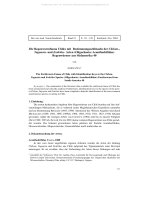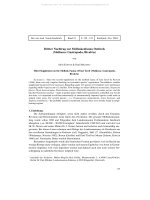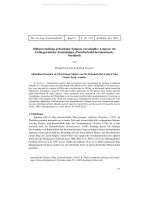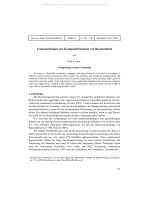Naturwissenschaftlich medizinischer Verein. Innsbruck Vol 92-0031-0039
Bạn đang xem bản rút gọn của tài liệu. Xem và tải ngay bản đầy đủ của tài liệu tại đây (1.73 MB, 9 trang )
© Naturwiss.-med. Ver. Innsbruck; download unter www.biologiezentrum.at
Ber. nat.-med. Verein Innsbruck
Band 92
S. 31 - 39
Innsbruck, Dez. 2005
The Invasive Green Alga Caulerpa racemosa (Caulerpales:
Ulvophyceae) on the Coast of Kalimnos (Southern Sporades, Greece)
with Comments on Taxonomy and Distribution in the Mediterranean
by
Georg GÄRTNER*)
S y n o p s i s : The pantropical coenocytic green alga Caulerpa racemosa colonized as
a Lessepsian migrant the Mediterranean after the opening of the Suez Canal. Within the last
decades it spreads also into the Western Mediterranean basin as a possibly new invasive
variety. On the coast of the Greece island Kalimnos (Southern Sporades) it is recorded for
the second time, obviously spreading along the Western coastal areas. On the basis of thallus morphology the samples were identified as an endemic West-Australian Caulerpa
racemosa var. cylindracea (SONDER) VERLAQUE, HUISMAN & BOUDOURESQUE. Additional
comments on taxonomy and distribution in the Mediterranean are given.
K e y w o r d s : Caulerpa racemosa, invasive variety, Mediterranean, Kalimnos, taxonomy, distribution
1. Introduction:
Invasive plant species representing different taxonomic groups are well known since
many decades and problems caused by them are being recognized worldwide (WEBER
2003, POWELL 2004). Among tropical algae introduced into the Mediterranean the coenocytic (siphonous) green algae Caulerpa racemosa (FORSSKÅL) J. AGARDH and C. taxifolia
(VAHL) C. AGARDH are well documented since many years but also members of brown and
red algae from tropical and temperated regions (e.g. Colpomenia peregrina (SAUVAGEAU)
HAMEL, Sargassum muticum (YENDO) FENSHOLT or Acrothamnion preisii (SONDER)
WOLLASTON have been well acclimatized there (BOUDOURESQUE et al. 1992). An example
of an invasive freshwater alga from tropical habitats into temperate waters is the occurrence of the tropical red alga Compsopogon coeruleus (BALBIS) MONTAGNE which was mainly distributed into aquaria but seems to be naturalized in some American and European
regions (SHEATH & SHERWOOD 2002, SHEATH 2003, STOYNEVA et al. 2005).
Dedicated to Prof. Sigmar Bortenschlager in honour of his 65th anniversary.
*)
Adress of author: Univ. Doz. Dr. Georg Gärtner, Institute of Botany, Faculty of Biology, LeopoldFranzens-University Innsbruck, Sternwartestr. 15, A-6020 Innsbruck (Austria).
31
© Naturwiss.-med. Ver. Innsbruck; download unter www.biologiezentrum.at
Caulerpa racemosa s.l. (Caulerpales, Ulvophyceae) is widely distributed in tropical and
subtropical seas and numerous varieties and forms are described (TAYLOR 1960, VERLAQUE
et al. 2000). It is recorded from the Red Sea, Indian Ocean (Arabian coasts, India, Ceylon),
Australian coasts, Philippines, Japan, Tahiti, and West Indies (NIZAMUDDIN 1991).
According to ALEEM (1950) the species can be described as pantropical. With the opening
of the Suez Canal in October 1869 an artificial contact between two different marine biota,
the Read Sea and the Mediterranean was created. Surprisingly not an intermingling of these
biota took place but a one-sided invasion of the Mediterranean by a well-defined diversity
of plants and animals of the Red Sea was the result. For this phenomenon the term
“Lessepsian Migrants” was created and C. racemosa was one of them. “Lessepsian
Migrants”1) was coined by POR (1969) firstly for the unidirectional limited migration of the
Red Sea species into the Mediterranean but later treated in a wider perspective (POR 1978)
including Anti-Lessepsian Migration (from the Mediterranean into the Red Sea) and even
discussing other Inter-Oceanic Contacts through shipping canals etc.
The first occurrence of C. racemosa was documented from the coast of Tunisia by
HAMEL (1926 ). Up to the 1990s it was recorded frequently in the East Mediterranean basin
(POR 1978, RIBERA & BOUDOURESQUE 1995, VERLAQUE et al. 2000) as a member of the
“Lessepsian migrants” (POR 1969). Some authors consider in mistakable manner such
migrants among algae and macrophytes as members of a “Lessepsian flora” (FAMÀ et al.
2000), negoting POR’s terminology. The fast colonization of new areas in the
Mediterranean, especially the Central and Western areas within the last decade by a new
invasive variety of C. racemosa led to the hypothesis of VERLAQUE et al. (2000) that it
might be a more recent introduction than a former Lessepsian migration. This was recently confirmed (VERLAQUE et al. 2003). The dramatic and continous expansion of this recent
invasive taxon is also facilitated by its asexual reproduction which is the rule in Caulerpaceans and known of the invasive C. racemosa as well as from the related C. taxifolia
(PIAZZI et al. 1997). For the island of Kalimnos the invasive variety of Caulerpa racemosa was sampled 1997 for the first time (VERLAQUE et al. 2000 but without further details).
Our studies document its appearance continuously along the Western coastal regions of the
island.
2. Material and Methods :
Thalli of C. racemosa were collected on different localities along the West Coast of the Island
Kalimnos (Southern Sporades, Greece, fig. 1) in the infralittoral zone during August 2002 at 2 – 4 m
depth in a moderately exposed area between calcareous rocks and sand in extended beds of Posidonia
oceanica (L.) DELILE. Caulerpa formed dense netlike populations intermingled with an algal community dominated by Anadyomene stellata (WULFEN) C. AGARDH, Flabellia petiolata (TURRA)
NIZAMUDDIN, Halimeda tuna (ELLIS & SOLANDER) LAMOUROUX, Cladophora spec., Jania rubens (L.)
LAMOUROUX, Corallina elongata ELLIS & SOLANDER, Ceramium cf. ciliatum (ELLIS) DUCLUZEAU, and
Cystoseira spec. Samples were dried and deposited in the author’s herbarium and in the herbarium
1)
Ferdinand Vincomte de Lesseps (1805 – 1894) builder of the Suez Canal.
32
© Naturwiss.-med. Ver. Innsbruck; download unter www.biologiezentrum.at
of the Botanical Institute of the University of Innsbruck (IB). Photographs from herbarium sheets
were taken with a Nikon camera. For microscopic photographs a stereo microscope Olympus SZH10
and a videoprinter Mitshubishi CP700 were used. Morphological investigation (especially measurements of thalli) was done on living material after collecting. One photograph of a thalli (fig. 5) collected on the coast of the island Samos was placed at the author’s disposal by the courtesy of Prof.
Christian Körner, Bale, Switzerland, in May 2005.
3. Results and Discussion:
The examined species (figs. 3 – 4) show slender siphonous thalli, stolons 20 – 100 (200) cm long and 1 – 2 mm thick, cylindrical. Stolons attached to the substratum by thin,
pale and finally ramified rhizoids which are 10 – 20 mm long and up to 0,5 (-1) mm in diameter. The stolons bear erect, cylindrical assimilators in irregularly intervals on their axes
with vesiculate clavate branchlets (ramuli), distichously or radially arranged, 2,5 – 3 (-4)
mm long and 1 - 2 mm in diameter, with rounded but often slightly flattened apices. This
agrees with samples illustrated by NIZAMUDDIN (1991) from Libya (fig. 6). PANAYOTIDIS &
MONTESANTO (1994) pictured and determined a C. racemosa var. macrophysa (KÜTZING)
TAYLOR from Greece, but their drawing doesn’t coincide with the figures given by TAYLOR
(1928). The remarkable morphological variability of C. racemosa s.l. was summarized by
PANAYOTIDIS & MONTESANTO (1994), who also paid attention to the fact, that size of assimilators and placement of ramuli varies according to the light conditions in culture, as
experimentally studied by CALVERT (1976). There are very few data on the development of
thallus architecture and morphology during the year from the field and also some classical
descriptions and illustrations from herbarium material or alcohol preserved specimens are
1
2
Fig. 1: Map of the sampling site.
Fig. 2: Map of the sampling localities (arrows) on Kalimnos.
33
© Naturwiss.-med. Ver. Innsbruck; download unter www.biologiezentrum.at
s
s
Fig. 3: Caulerpa racemosa var. cylindracea stolons (s) with assimilators and the vesiculate,
distichously arranged branchlets with slightly flattened apices. Attachment of assimilators to
the stolons basically slightly inflated (arrow). Scale bar graduation: 1 mm. (Herbarium specimens, Kalimnos).
Fig. 4: C. racemosa var. cylindracea (Herbarium specimen, Kalimnos) with assimilators of different
size arranged in irregularly intervals on the stolon. Scale bar: 15 mm.
34
© Naturwiss.-med. Ver. Innsbruck; download unter www.biologiezentrum.at
Fig. 5: C. racemosa var. cylindracea freshly collected specimen from Samos, the assimilators slightly inflated basically (arrow); r = rhizoids, with epiphytic algae. Scale bar: 15 mm. (Courtesy:
C. KÖRNER).
Fig. 6: Original drawings (figs. 227 and
228) of the first record of C. racemosa from the Libyan coast by M.
NIZAMUDDIN (1991:16), seemingly the “invasive taxon”; assimilators basically inflated (arrows!).
35
© Naturwiss.-med. Ver. Innsbruck; download unter www.biologiezentrum.at
only partially useable for determination of varieties. An interesting morphological detail
could be of determinative character and was recently shown by VERLAQUE et al. (2003) on
material from C. racemosa (the invasive variety) from Mediterranean and on alcohol preserved samples of C. cylindracea SONDER, endemic to Western Australia. The attachment
of upright axes (assimilators) to the stolon seems to be very distinct, it is slightly inflated.
This is shown here on figures 6 and 7, representing the original drawings of NIZAMUDDIN
(1991:16, figs. 227, 228, arrows), and of PANAYOTIDIS & MONTESANTO (1994:160, fig.1,
arrows) and also on our fig. 5 from the fresh sample of Samos island (arrow). On dry herbarium material this detail is more or less difficult to detect but is also visible (fig. 3,
arrow).
C. racemosa (in a variety comparable with tropical taxa) was 1994 reported by PIAZZI
et al. from the Eastern Mediterranean basin on 8 coastal localities from Egypt northwards
to the coasts of Rhodos, from Tunisia, Sicily and for the first time from Western Mediterranean near Livorno (fig. 8). By comparison of the photograph (fig. 3 on p. 186 given
by PIAZZI et al. 1994) it could be also the “invasive species”. A distribution map (fig. 9) by
FAMÀ et al. (2000) shows the rapid invasion into the Central and Western Mediterranean.
Until 2002 it has been recorded from at least 11 Mediterranean countries and all the large
islands (VERLAQUE et al. 2003).
VERLAQUE et al. (2000) reviewed the Mediterranean records of C. racemosa and demonstrated that three distinct taxa (morphologically but also genetically different varieties)
exist. In a recent study of the whole Mediterranean C. racemosa-complex with inclusion of
morphological and molecular data VERLAQUE et al. (2003) came to the result, that the inva-
Fig. 7: Original drawings of C. racemosa
(“invasive taxon”?) with inflated assimilators (arrows) by PANAYOTIDIS &
MONTESANTO (1994:160) and determined
as C. racemosa var. macrophysa (KÜTZING) TAYLOR.
36
© Naturwiss.-med. Ver. Innsbruck; download unter www.biologiezentrum.at
sive variety from the Mediterranean is in good agreement with the Caulerpa racemosa var.
laetevirens f. cylindracea (SONDER)WEBER - VAN BOSSE from Western Australia (basionym
C. cylindracea SONDER). Based on their studies VERLAQUE et al. (2003) proposed the new
combination Caulerpa racemosa var. cylindracea (SONDER) VERLAQUE, HUISMAN &
BOUDOURESQUE for this invasive species. According to literature and available morphological data our material agrees with this taxon, which seemingly has up to now invaded the
whole coastal areas of the Southeastern Mediterranean basin. The coasts of many islands,
like the Southern Sporades and obviously also Kalimnos are now throughout inhabited by
Fig. 8: Map of the distribution of C. racemosa s. l. in the Mediterranean up to 1994 (from PIAZZI et
al. 1994:184, arrow indicates the first record in the North-Western Mediterranean near
Livorno).
Fig. 9: Map of the distribution of C. racemosa s. l. in the Mediterranean (from FAMÀ et al. 2000:351;
abbreviations: GC=Gran Canaria, FU=Fuerteventura, MA=Marseille, LI=Livorno,
CM=Capo Miseno, SA=Salerno, CR=Capo Rizzuto, CO=Capo Molini, RH=Rhodes Island.)
37
© Naturwiss.-med. Ver. Innsbruck; download unter www.biologiezentrum.at
this Australian migrant, which seems to be one of the most adapted and invasive algal species in the Mediterranean. Its negative impact on marine algal communities has been reported already (CECCHERELLI et al. 2001) and will be of great ecological relevance in future.
4. References:
ALEEM, A. A. (1950): Some new records of marine algae from the Mediterranean Sea with reference
to their geographical distribution. – Acta Hort. Gothoburg. 18: 275 - 287.
BOUDOURESQUE, C. F., A. MEINESZ, M. VERLAQUE & M. KNOEPFFLER-PEGUY (1992): The expansion
of the tropical alga Caulerpa taxifolia (Chlorophyta) in the Mediterranean. – Cryptogamie,
Algol. 13: 143 - 154.
CALVERT, H. E. (1976): Culture studies on some Florida species of Caulerpa: morphological responses to reduced illumination. – Br. Phycol. J. 11: 203 - 214.
CECCHERELLI, G., D. CAMPO & L. PIAZZI (2001): Some ecological aspects of the introduced alga
Caulerpa racemosa in the Mediterranean: way of dispersal and impact on native species. – Biol.
Mar. Medit. 8: 94 - 99.
FAMÀ, P., J. L. OLSEN, W. T. STAM & G. PROCACCINI (2000): High levels of intra- and inter-individual polymorphism in the rDNA ITS1 of Caulerpa racemosa (Chlorophyta). – Eur. J. Phycol. 35:
349 - 356.
HAMEL, H. (1926): Quelques algues rares ou nouvelles pour la flore méditerranéenne. – Bull. Mus.
Nat. Sci. Nat. Paris 32: 420.
NIZAMUDDIN, M. (1991): The Green Marine Algae of Libya. – Elga Publ., Bern, 227 pp.
PANAYOTIDIS, P. & B. MONTESANTO (1994): Caulerpa racemosa (Chlorophyta) on the Greek coasts.
– Cryptogamie, Algol. 15: 159 - 161.
PIAZZI, L., E. BALESTRI & F. CINELLI (1994): Presence of Caulerpa racemosa in the North-Western
Mediterranean. – Cryptogamie, Algol. 15: 183 - 189.
PIAZZI, L., E. BALESTRI, M. MAGRI & F. CINELLI (1997): Expansion de l’ algue tropicale Caulerpa
racemosa (FORSSKÅL) J. AGARDH (Bryopsidophyceae, Chlorophyta) le long de la côte Toscane
(Italie). – Cryptogamie, Algol. 18: 343 - 350.
POR, F. D. (1969): The Canuellidae (Copepoda, Harpacticoida) in the waters around the Sinai
Peninsula and the problem of “Lessepsian” migration of this family. – Israel J. Zool. 18: 169 178.
(1978): Lessepsian Migration. – In: BILLINGS, W. D., F. GOLLEY, O. L. LANGE & J. S. OLSON
(eds.), Ecological Studies 23, Springer Berlin, Heidelberg, New York, 228 pp.
POWELL, M. R. (2004): Risk assessment for invasive plant species.– Weed Technology 18: 1305 1308.
RIBERA, M. A. & C. F. BOUDOURESQUE (1995): Introduced marine plants, with special reference to
macroalgae: mechanisms and impact. – In: ROUND, F. E., D. J. CHAPMAN (eds.), Progress in
Phycological Research 11: 187 - 268, Biopress Ltd., Bristol.
SHEATH, R. (2003): Red Algae. – In: WEHR, J. D. & R. G. SHEATH (eds.), Freshwater Algae of North
America. Ecology and Classification: 197 - 224. – Academic Press, Amsterdam.
SHEATH, R. G. & A. R. SHERWOOD (2002): Phylum Rhodophyta (Red Algae). – In: JOHN, D. M., B.
A. WHITTON & A. J. BROOK (eds.), The Freshwater Algal Flora of the British Isles: 123 - 143.
– Cambridge Univ. Press, Cambridge.
STOYNEVA, M. P., K. VANHOUTTE & W. VYVERMAN (2005): First record of the tropical invasive alga
Compsopogon coeruleus (BALBIS) MONTAGNE (Rhodophyta) in Flanders (Belgium). – In: N.
OGNYANOVA. & K. MANOYLOVA (eds.), Honourable book dedicated to the 70th Anniversary of
Prof. D. Temniskova, Pensoft, Sofia (in press).
38
© Naturwiss.-med. Ver. Innsbruck; download unter www.biologiezentrum.at
-
(1960): Marine algae of the Eastern Tropical and Subtropical Coasts of the Americas. – Univ.
Michigan Press, 870 pp.
TAYLOR, W. R. (1928): The Marine Algae of Florida with special reference to the Dry Tortugas. –
Carnegie Inst. of Washington, publ. no. 379, 219 pp.
(1960): Marine algae of Eastern Tropical and Subtropical Coasts of the Americas. –
Univ.Michigan Press, 870 pp.
VERLAQUE, M., C. F. BOUDOURESQUE, A. MEINESZ & V. GRAVEZ (2000): - The Caulerpa racemosa
complex (Caulerpales, Ulvophyceae) in the Mediterranean Sea. – Bot. Mar. 43: 49 - 68.
VERLAQUE, M., C. DURAND, J. M. HUISMAN, C. F. BOUDOURESQUE & Y. LE PARCO (2003): On the
identity and origin of the Mediterranean invasive Caulerpa racemosa (Caulerpales,
Chlorophyta). – Eur. J. Phycol. 38: 325 - 339.
WEBER, E. (2003): Invasive Plant Species of the World. – CABI Publishing, Oxon, 548 pp.
39









